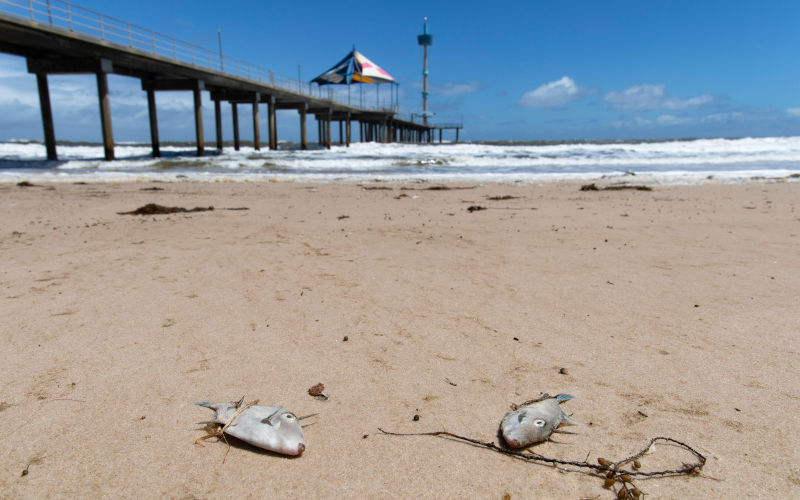Australia’s toxic algal bloom has killed 87,000 animals – and summer’s coming
November 21, 2025
An unprecedented toxic algal bloom in South Australia has devastated marine life, tourism and fishing. With no clear end in sight, scientists warn it may become a permanent feature of local waters – and research cuts risk making it worse.
An underwater bloom of toxic algae has wreaked havoc off the coast of South Australia since mid-March 2025. After eight months, this harmful algal bloom is the longest and one of the most environmentally devastating events ever recorded in Australian waters.
The algal bloom is predominantly in Gulf St Vincent and has affected 30 per cent of South Australia’s coastline. The bloom has affected more than 390 species, with more than 87,000 dead animals reported to the iNaturalist database.
There is still no end in sight for this environmental disaster. It’s impossible to know exactly what might happen to this vast toxic bloom this summer, as the ocean heats up.
But we have models and scientific knowledge to guide our predictions.
The algal bloom has led to troubling times in South Australia. The commercial and recreational fishing sectors, tourist industry, the public and even politicians have suffered from its detrimental effects.
The algal bloom saga is full of surprise twists and turns, including the initial identification of the algae as Karenia mikimotoi, government speculation about its causes (frequently aired in television ads), and the resignation of South Australia’s Environment Minister Susan Close.
This was followed by a statement from South Australia’s Premier, Peter Malinauskas, that the algal bloom was not toxic (it is). Then came the dangerous relocation of algae-affected oysters that could have introduced the algae to other pristine waters.
The saga continued, with Malinauskas announcing in late October that the algal bloom may eventually disappear, which turned out to be overly optimistic and incorrect.
Then came the recent discovery of a novel brevetoxin-producing species, K. cristata that appears to have dominated the algal bloom since July. Recently, the algal bloom reappeared near Victor Harbor, while the worst fish kill since the bloom started occurred along Adelaide’s beaches.
There have been federal and state senate inquiries into the algal bloom, and now important research on the algal bloom won’t be able to continue as six researchers in this space, including myself, have lost their positions at Flinders University in a restructure.
From the beginning, state authorities were optimistic about the algal bloom. They said storms and colder waters would make it soon disappear and downplayed potential public health impacts, claiming the algae did not produce a toxin.
The release of my modelling was a turning point.
In the worst-case scenario, the model predicted the algal bloom would initially weaken and shrink over the cooler winter months but intensify and affect new areas, including Spencer Gulf, the following summer.
My modelling predictions, based on the known growth characteristics of K. mikimotoi, were the first science-based research suggesting the algae may become an ongoing problem.
Shauna Murray, a marine biologist at the University of Technology Sydney, and her colleagues eventually unravelled several _Karenia_ species that were previously prematurely grouped as K. mikimotoi. This discovery, which was made public in a pre-print article that has not yet been peer-reviewed, was another significant game changer for two reasons.
Cell counts of Karenia species are published on the state government’s algal bloom water testing open data dashboard. Over the entire measurement period, K. cristata, which dominates the algal bloom mix, showed very high concentrations of several million cells per litre in Gulf St Vincent.
Such high algal concentrations are different to my modelling predictions. Based on the growth characteristics of K. mikimotoi, these suggested a decrease in algal levels over the winter months.
In comparison, Spencer Gulf and the northwest marine region had low toxic algal concentrations during the entire period, which my model predicted. Relatively high levels (>100,000 cells per litre) near the Arno Bay jetty, which could be due to human influences rather than current, are still concerning.
Recent declines in algal cell counts of K. cristata along South Australian metropolitan beaches gave the state government a new reason to believe the algal bloom may eventually disppear. But could this be false hope?
It is not possible to predict the future development of toxic algal bloom in South Australian waters with any certainty. However, it seems the worst-case scenario of my predictions still holds. This suggests the algal bloom will remain a permanent feature of the two gulfs for many years.
The important difference could be that K. cristata (not included in the model yet) will flare up during the colder months, when it may grow best. And other Karenia species such as K. mikimotoi may dominate the algal bloom during the warmer months, in a never ending cycle. Only good scientific monitoring and high-quality research can verify this hypothesis.
It’s difficult for me to imagine the scientific mechanisms that would see the algal bloom disappear. While the bloom cannot be controlled by human intervention, continued scientific studies are required to understand how it functions. Like many others, I too hope the algal bloom will eventually disappear.
Republished from The Conversation, 20 November 2025
The views expressed in this article may or may not reflect those of Pearls and Irritations.
